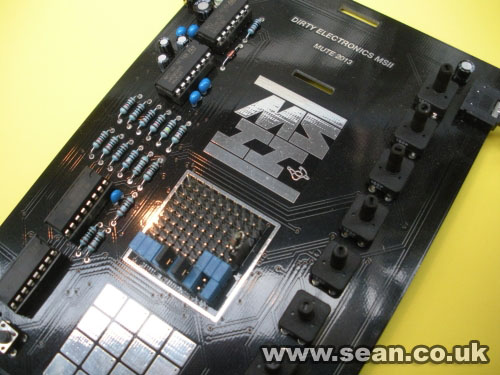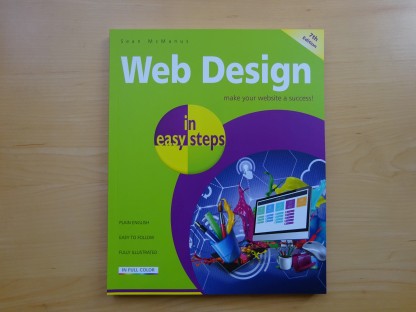
Coding Compendium
A free 100-page ebook collecting my projects and tutorials for Raspberry Pi, micro:bit, Scratch and Python. Simply join my newsletter to download it.
March 2015
Is it an instrument or a toy? A short review and some example music made using the Korg Kaossilator synth, including a comparison with the Mute Synth II. By Sean McManus.
At Christmas, I visited the Independent Label Market Fair, which was like a farmer's market for record labels, where they could bring along their wares and sell directly to the public. One of the attractions was the opportunity to get a Mute Synth II, a new instrument that iconic electronic music label Mute had created. At the event, I had an opportunity to try it out, using a prototype (my photo shows different text to the released ones!).

The Mute Synth II prototype
Unfortunately, I couldn't get it to produce anything other than some random electronic feedback type sounds. Although it is well suited to making those kinds of sounds, I've heard it produce more bass type sounds in demos posted online. I wasn't really able to give it a fair chance - the tiny stall was packed at opening time and people were clamouring for the music on sale, so if you're interested please don't be put off by my few minutes with it. But much as I wanted to like it (even love it), I decided it wasn't for me.
It got me thinking about alternative instruments (there are lots of them) and what makes them useful as instruments, as opposed to musical (or in some cases just noisy) toys. Here are what I think defines a useful instrument:
It's a bit rough and ready, but I'd say things that score low in the first two of these qualities are toys, and I'm also looking for the other two in electronic instruments I use.
By these guidelines, the Mute Synth doesn't score well based on my limited experience with it. It's probably judging it unfairly (like an elephant crticised for not being able to climb a tree), but these are the things I'm currently looking for in the instruments I use, so it just means me and the Mute Synth aren't a good match for each other right now. There might well come a time when I try it again (I do still really want to like it).
This brings me to another alternative instrument I discovered recently and did buy, second hand. It's the Korg Kaossilator, a handheld device that incorporates a touch-sensitive Kaoss pad for performance.

Photo of the Korg Kaossilator
The device fits in the palm of your hand and offers 100 sounds, split between lead, acoustic, bass, chord, special effect, and drum sounds and patterns. The quality of the sounds is superb, although you can't edit the sounds (for example changing the attack or decay). What you can do is use the kaoss pad to perform with them. On lead sounds, for example, you slide your finger left and right for pitch (which covers two octaves) and up and down to control the vibrato, cutoff, level, LFO speed, echo time or other parameter. For the trumpet voice, you move your finger up and down the pad to change the simulated breath pressure. It's an intuitive way to perform, and gives you full musical control over the output, including an expressive way to change the sounds while performing.
There are 50 ARP patterns that can be applied to the sounds, and you can record a short loop and repeat it, laying in other parts. The looping is a nice addition for jamming and experimenting but a bit limited so I will focus on recording the audio output so I can more easily edit it later. The device doesn't support MIDI, but has audio output for recording.
You can change the tonic note and scale type (out of 31), so you can easily incorporate it into musical pieces created with other instruments. As well as the scales you might expect, it supports lots of more daring scales including Egyptian, Hawaiian, Bali Island Pelog (eh?) and Gypsy.
For my first piece using it, used some sound effects from NASA to add some texture and created a spacey, chilled out tune, which you can hear below:
Although its name incorporates two things I don't particularly like (chaos and procrastination), I really like the device and look forward to making more music with it. It's a relatively inexpensive way to get some new hardware-based sounds, and an expressive new way of performing into your home studio. This first edition is available fairly cheaply on eBay from time to time, although there has been a second generation and a Kaossilator Pro+ device (presumably designed to keep you awake with even more sounds).
Listen to my music and find more articles about home recording here.
For updates, follow me on Twitter.
© Sean McManus. All rights reserved.
Visit www.sean.co.uk for free chapters from Sean's coding books (including Mission Python, Scratch Programming in Easy Steps and Coder Academy) and more!

A free 100-page ebook collecting my projects and tutorials for Raspberry Pi, micro:bit, Scratch and Python. Simply join my newsletter to download it.

Web Design in Easy Steps, now in its 7th Edition, shows you how to make effective websites that work on any device.

Power up your Microsoft Excel skills with this powerful pocket-sized book of tips that will save you time and help you learn more from your spreadsheets.

This book, now fully updated for Scratch 3, will take you from the basics of the Scratch language into the depths of its more advanced features. A great way to start programming.

Code a space adventure game in this Python programming book published by No Starch Press.

Discover how to make 3D games, create mazes, build a drum machine, make a game with cartoon animals and more!